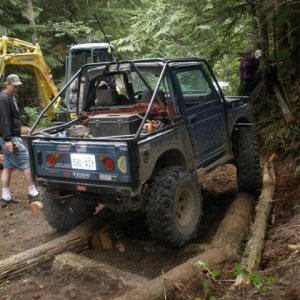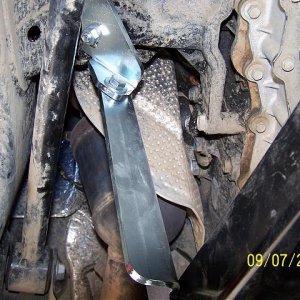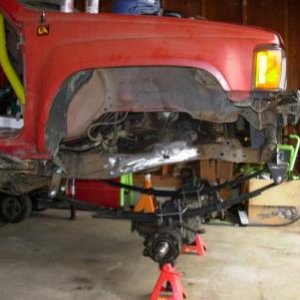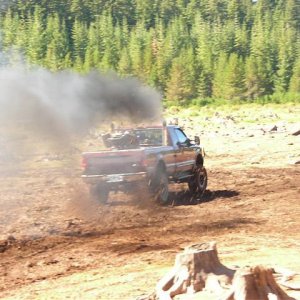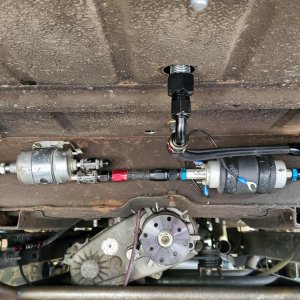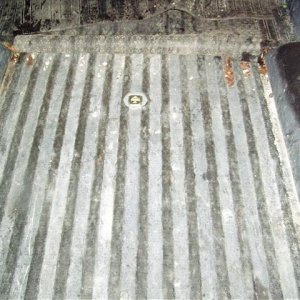Re: Tellico Closure Info
Jan 1 it begins...
It's official...Tellico is closed from January 1 to March 31st. Lower 2, 7, a portion of 8, and 9 are all closed for a period not to exceed 1 year. See the text of the Decision Memo below (in multiple posts):
DECISION MEMO
Forest Supervisor's Orders for the
Upper Tellico Off-Highway Vehicle Area
USDA Forest Service Southern Region
Nantahala National Forest
Tusquitee Ranger District
Cherokee County, North Carolina
DECISION
I have decided to put into force two Forest Supervisor's Orders for the Upper Tellico Off-Highway (OHV) Area on the Tusquitee Ranger District of the Nantahala National Forest. This decision is based on information gathered during a recent condition survey of high risk trail segments, and on public comments received during the scoping period. The Orders implement the following management measures:
1. A one-year closure of Lower Trail 2 (from the intersection with Road 420 west to Road 402), Trail 7, a portion of Trail 8 (from the intersection with Trail 9 to the intersection with Trail 10A), and Trail 9 in the Upper Tellico OHV area which prohibits operating motor vehicles on these trails during the closure period and sets penalties for violating the provisions of this Order.
2. A seasonal closure of the Upper Tellico OHV Area which prohibits operating motor vehicles on trails within the Area during the period between January 1 and March 31 each year and sets penalties for violating the provisions of this Order.
The following persons are exempted from these orders:
• Persons with a permit from the Forest Service specifically authorizing the otherwise prohibited act or omission.
• Any Federal, State, or local officer, or member of an organized rescue or firefighting force in the performance of an official duty.
• Owners or lessees of land in the Closure Area are exempt from the prohibitions listed above to the extent necessary to gain access to their land.
• Residents in the Closure Area are exempt from the prohibitions to the extent necessary to gain access to their residences.
PURPOSE AND NEED FOR THE ACTION
Direction in the Land and Resource Management Plan for the Nantahala National Forest (Amendment 5, 1994) identifies the lands within the Upper Tellico OHV Area as existing in Management Areas 1B and 2C. The description for these management areas state "These lands are managed to provide opportunities for public enjoyment of the Forest through motorized recreation – driving for pleasure in conventional and four-wheel-drive vehicles as well as machines commonly classified as ORV's. While these uses will be encouraged on appropriate roads and trails, use will not be allowed to damage the Forests' environment." (MA 1B, p. III-57). Also, "Provide opportunities for vehicles commonly classified as ORV's on designated routes primarily within designated ORV areas... if such use does not adversely affect other resources." (MA 2B, p. III-67). These actions are needed to correct ongoing impacts to area waters and aquatic resources caused by sediment from the Upper Tellico road and trail system.
In October and November of 2007, the Forest Service conducted an initial condition survey of Upper Tellico roads and trails identified as "high risk" for sedimentation due to steepness or close proximity to water (about 16.5 miles of trail were evaluated). Drainage features constructed to remove water from trails were assessed - 61 % of these drainage features were properly functioning during the assessment. All trail segments assessed were contributing sediment to nearby streams to some degree. The Water Erosion Prediction Project (WEPP) computer model was used to compare trail management alternatives to the current condition (http://topsoil.nserl.purdue.edu/nserlweb/weppmain/). The sediment reductions projected to occur based on the closure of various trail segments (and the seasonal closure) were evaluated. These projections indicated that closing the proposed trail segments would maximize sediment reduction while also maintaining a viable trail system.
All trail bridges in the Upper Tellico system were also assessed for safety. Three trail bridges on Trail 8 were determined to be unsafe for OHV traffic and a portion of the trail was closed under an emergency order. Since it will not be possible to complete repairs to these bridges during the emergency closure period, this portion of Trail 8 was added to the year-long temporary trail closure order.
Scientific studies addressing the impacts of a winter seasonal closure were also reviewed. Multiple past studies have shown the degree of soil compaction and rutting, and therefore erosion potential, on a road surface is related to the number of freeze-thaw cycles, as well as the amount and type of traffic present. In areas where soil moisture is already high, there is increased potential for erosion (Halvorsen et al. 2001). Frequent freeze-thaw cycles typically occur during the winter months in the Southern Appalachian Mountains (Williams 1964). Also, during winter months, soil structure and function change (Sulkava and Huhta 2003) and most vegetation is dormant, which reduces natural buffer ability to assimilated eroded soil. And additionally, estimated increases in winter water yield resulting from the loss of hemlock from the forest (due to the effects of the hemlock wooly adelgid) approach 30% (Ford and Vose 2007). These known and potential increases in sedimentation of local streams during winter months affect aquatic habitat at a critical time for many aquatic species, including native brook trout (Schmitt et al. 1993).
Proposed Action 1, closure on Lower Trail 2 (from the intersection with Road 420 west to Road 402), Trail 7, a portion of Trail 8 (from the intersection with Trail 9 to the intersection with Trail 10A),and Trail 9, is needed to provide immediate resource protection measures. These trails have been identified as contributing to sedimentation in the Tellico River system. The closure will allow time for further evaluation of the resource condition associated with these trails, planning for long-term resource protection, and needed repairs to correct impacts to the area waters and aquatic resource.
Proposed Action 2, seasonal closure of the OHV Area, is needed for the purpose of preventing resource damage during a period when the area is most vulnerable to resource damage, and to allow for intensive maintenance of system trails. Seasonal closures have already been implemented at other all other mountain OHV areas on the National Forests in North Carolina.
The actions will be implemented pursuant to 36 CFR 261.50 (b) which states, "The Chief, each Regional Forester, each Experiment Station Director, the Administrator of the Lake Tahoe Basin Management Unit and each Forest Supervisor may issue orders which close or restrict the use of any National Forest System road or trail within the area over which he has jurisdiction."
REASONS FOR CATEGORICALLY EXCLUDING THE DECISION
These actions do not individually or cumulatively have a significant effect on the quality of the human environment, and therefore, are categorically excluded from documentation in an environmental impact statement (EIS) or an environmental assessment (EA). The specific category, identified in Forest Service Handbook 1909.15 "Environmental Policy and Procedures" is Section 31.12 Category 1: Orders pursuant to 36 CFR Part 261 – Prohibitions to provide short-term resource protection or to protect public health and safety.
FINDING OF NO EXTRAORDINARY CIRCUMSTANCES
No extraordinary circumstances exist that warrant further analysis and documentation in an EA or EIS. The District interdisciplinary team screened these actions for the presence of any one of the extraordinary circumstances identified in Amendment No. 1909.15-2007-1 to Forest Service Handbook 1909.15. Section 30.3 paragraph 2 lists the following resource conditions that were considered:
• Federally listed threatened or endangered species or designated critical habitat, species proposed for Federal listing or proposed critical habitat, or Forest Service sensitive species;
• Flood plains, wetlands, or municipal watersheds;
• Congressionally designated areas, such as wilderness, wilderness study areas, or national recreation areas;
• Inventoried roadless areas;
• Research natural areas;
• American Indians and Alaska Native religious or cultural sites;
• Archaeological sites, or historic properties or areas.
SCOPING AND PUBLIC INVOLVEMENT
The purpose of scoping is to determine the issues and concerns related to the proposal. Public involvement began on September 17, 2007 when a letter was mailed and emailed to groups and individuals known to be interested in management of the Upper Tellico OHV Area. The "scoping letter" requested comments on the proposed Forest Supervisor's Orders. As a result, approximately 200 responses from individuals, groups, organizations and other government agencies were delivered to us by mail, emailed, phoned in or by personal visit to the District office. These responses conveyed numerous issues, and are summarized in the Response to Public Comments, in the project file.
Additionally, approximately 700 form letters were received by email from those people who supported any and all closures of the trail system. And approximately 400 form letters were received from people who favored trail repairs and reroutes, but not trail closures.
In the 30 day scoping period that began on September 17 newspaper articles were published in the Asheville Citizen-Times, The Cherokee Scout, and the Clay County Progress.
FINDINGS REQUIRED BY OTHER LAWS
Forest Plan Consistency – The actions in this decision are consistent with the Land and Resource Management Plan for the Nantahala and Pisgah National Forests (Forest Plan) and all Amendments to the Forest Plan.
Endangered Species – Implementing the actions in this decision will not adversely affect threatened or endangered species, or result in loss of any other species' viability, or create significant trends towards Federal listing of the species under the Endangered Species Act.
Cultural Resources – The actions in this decision will not adversely affect any sites listed, or eligible for listing, in the National Register of Historic Places, nor will they cause the loss or destruction of significant scientific, cultural or historic resources.
NOTICE, COMMENT AND APPEAL OPPORTUNITIES
These actions are not subject to legal notice and opportunity to comment (36 CFR 215.4(a)). This decision is not appealable (36 CFR 215.12(f)).


